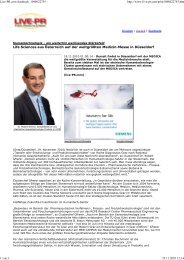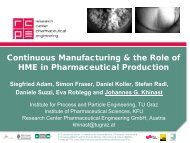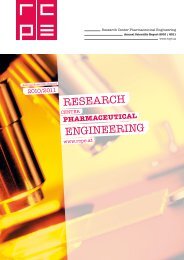Nanosuspensions as advanced printing ink for accurate ... - RCPE
Nanosuspensions as advanced printing ink for accurate ... - RCPE
Nanosuspensions as advanced printing ink for accurate ... - RCPE
Create successful ePaper yourself
Turn your PDF publications into a flip-book with our unique Google optimized e-Paper software.
G Model<br />
IJP-12101; No. of Pages 8<br />
ARTICLE IN PRESS<br />
J. Pardeike et al. / International Journal of Pharmaceutics xxx (2011) xxx– xxx 7<br />
Fig. 7. Visualization of the drop <strong>for</strong>mation. The pulse width is 25 �s, the pulse amplitude 100 V and the frequency 200 Hz. The final droplet size is 68.4 �m.<br />
droplet generator can be varied between 0 and 2 ms, allowing the<br />
observation of the drop <strong>for</strong>mation stages.<br />
Fig. 7 shows various stages in the development of a microdroplet.<br />
At the early stages a liquid jet is ejected from the aperture,<br />
which destabilizes and <strong>for</strong>ms a spherical shaped droplet. The rest of<br />
the liquid column is drawn back into the nozzle. The droplet break<br />
off occurs approximately 120 �s after the initial driving pulse.<br />
The droplet size and velocity were calculated b<strong>as</strong>ed on the<br />
droplet images using an in-house Matlab routine. Depending on the<br />
variation of the operating parameters of the dosing device droplet<br />
diameters between 56 and 84 �m and droplet velocities between<br />
0.5 and 1.5 m/s were obtained. By keeping frequency, electric voltage<br />
and impulse width constant, precise droplets with a highly<br />
reproducible diameter and velocity are achieved, which guarantees<br />
a high accuracy of the dosing <strong>for</strong> the production of personalized<br />
medicines.<br />
The experiments showed that the particle size of the folic<br />
acid nanosuspension w<strong>as</strong> sufficiently small, enabling undisturbed<br />
microdrop <strong>for</strong>mation. Even when the process had been halted <strong>for</strong><br />
about an hour no clogging of the drop ejector occurred. Furthermore,<br />
no overly wetted nozzle orifice and no buildup of solid<br />
deposits in or around the ejection hole were observed, which<br />
indicates that the developed nanosuspension is suitable <strong>for</strong> <strong>ink</strong>jettype<br />
<strong>printing</strong> technique used in the production of personalized<br />
medicines.<br />
The potential of using nanosuspension <strong>for</strong> dispensing APIs using<br />
microdrop technology compared to the application of drug solutions<br />
in <strong>ink</strong>jet type <strong>printing</strong> is miscellaneous. The possibility of<br />
processing poorly soluble drugs, the incre<strong>as</strong>e of stability of the <strong>for</strong>mulation,<br />
the wider range of applications <strong>for</strong> different APIs and<br />
the incre<strong>as</strong>e of the saturation solubility <strong>as</strong> well <strong>as</strong> the dissolution<br />
velocity are only some advantages. Especially <strong>for</strong> <strong>printing</strong> of<br />
<strong>for</strong>mulations with high API concentrations the effect of recrystallization<br />
of the dissolved API is excluded which often occurs when<br />
dosing highly concentrated solutions with an API content close to<br />
the saturation solubility. This recrystallization leads to a clogging<br />
of the ejector nozzle or an inhomogeneous application of the drug<br />
respectively which prevents an <strong>accurate</strong> and reliable production of<br />
personalized dosage <strong>for</strong>ms.<br />
4. Conclusion<br />
A nanosuspension that met the prerequisites <strong>for</strong> an <strong>ink</strong>jet-type<br />
<strong>printing</strong> technique with a particle size well below 5 �m and an<br />
active content of 10% (w/w) w<strong>as</strong> prepared via high pressure homogenization<br />
in a reproducible manner from the poorly soluble folic<br />
acid. Furthermore the nanosuspension had a good storage stability.<br />
Reducing the particle size to the nanometer range led to a significant<br />
incre<strong>as</strong>e in saturation solubility and dissolution velocity of folic<br />
acid compared to suspension, which is advantageous <strong>for</strong> the oral<br />
absorption of poorly soluble drugs. It w<strong>as</strong> also demonstrated that<br />
10% (w/w) folic acid nanosuspension can be printed on edible paper<br />
carriers via <strong>ink</strong>jet-type <strong>printing</strong> technique <strong>for</strong> the production of<br />
personalized medicines. Combining the advantages of <strong>for</strong>mulating<br />
poorly soluble drugs <strong>as</strong> nanosuspensions to reduces oral absorption<br />
problems with the <strong>ink</strong>jet-type <strong>printing</strong> technology <strong>for</strong> the preparation<br />
of personalized medicines can contribute to an effective and<br />
safe therapy <strong>for</strong> individual patients.<br />
Acknowledgement<br />
We acknowledge the financial support of the Austrian Federal<br />
Government in the framework of the COMET competence center<br />
funding program <strong>as</strong> well <strong>as</strong> from G.L. Pharma. We thank Maxi<br />
Pardeike <strong>for</strong> illustrating the graphical abstract.<br />
References<br />
Anderberg, E.K., Nyström, C., Bisrat, M., 1988. Physicochemical <strong>as</strong>pects of drug<br />
rele<strong>as</strong>e VII. The effect of surfactant concentration and drug particle size on solubility<br />
and dissolution rate of felodipine, a sparingly soluble drug. Int. J. Pharm.<br />
47, 67–77.<br />
Ambrus, R., Kocbek, P., Kristl, J., Sibanc, R., Rajko, R., Szabo-Revesz, P., 2009.<br />
Investigation of preparation parameters to improve the dissolution of poorly<br />
water-soluble meloxicam. Int. J. Pharm. 381, 153–159.<br />
Cerdeira, A.M., Mazzotti, M., Gander, B., 2010. Miconazole nanosuspensions: influence<br />
of <strong>for</strong>mulation variables on particle size reduction and physical stability.<br />
Int. J. Pharm. 396, 210–218.<br />
Dolenc, A., Govedarica, B., Dreu, R., Kocbek, P., Srcic, S., Kristl, J., 2010. Nanosized<br />
particles of orlistat with enhanced in vitro dissolution rate and lip<strong>as</strong>e inhibition.<br />
Int. J. Pharm. 396, 149–155.<br />
Giron, D., 1995. Thermal analysis and calorimetric methods in the characterisation<br />
of polymorphs and solvates. Thermochim. Acta 248, 1–59.<br />
Grant, D.J.W., Brittain, H.G., 1995. Solubility of pharmaceutical solids. In: Brittain,<br />
H.G. (Ed.), Physical Characterization of Pharmaceutical Solids. Marcel Dekker,<br />
New York, pp. 321–386.<br />
Grau, M.J., Kayser, O., Müller, R.H., 2000. <strong>Nanosuspensions</strong> of poorly soluble<br />
drugs—reproducibility of small scale production. Int. J. Pharm. 196, 155–159.<br />
Grunenberg, A., 1997. Polymorphism and thermal analysis of pharmaceutical agents.<br />
Pharm. Unserer Z. 26, 224–231.<br />
Heudi, O., Kilinc, T., Fontannaz, P., 2005. Separation of water-soluble vitamins<br />
by reversed-ph<strong>as</strong>e high per<strong>for</strong>mance liquid chromatography with ultra-violet<br />
detection: application to polyvitaminated premixes. J. Chromatogr. A 1070,<br />
49–56.<br />
Jacobs, C., Müller, R.H., 2002. Production and characterization of a budesonide<br />
nanosuspension <strong>for</strong> pulmonary administration. Pharm. Res. 19, 189–194.<br />
Jang, D., Kim, D., Moon, J., 2009. Influence of fluid physical properties on <strong>ink</strong>-jet<br />
printability. Langmuir 25, 2629–2635.<br />
Keck, C.M., Müller, R.H., 2006. Drug nanocrystals of poorly soluble drugs produced<br />
by high pressure homogenisation. Eur. J. Pharm. Biopharm. 62, 3–16.<br />
Kipp, J.E., 2004. The role of solid nanoparticle technology in the parenteral delivery<br />
of poorly water-soluble drugs. Int. J. Pharm. 284, 109–122.<br />
Latscha, H.P., Klein, H.A., 1995. Analytische Chemie. Springer Verlag,<br />
Berlin/Heidelberg.<br />
Lee, E.R., 2003. Fluid engineering of microdrop ejectors. In: Lyshevski, S.E. (Ed.),<br />
Microdrop Generation. CRC Press LCC, pp. 177–188.<br />
Li, X., Gu, L., Xu, Y., Wang, Y., 2009. Preparation of fenofibrate nanosuspension and<br />
study of its pharmacokinetic behavior in rats. Drug Dev. Ind. Pharm. 35, 827–833.<br />
Mauludin, R., Müller, R.H., Keck, C.M., 2009. Kinetic solubility and dissolution velocity<br />
of rutin nanocrystals. Eur. J. Pharm. Sci. 36, 502–510.<br />
Merisko-Liversidge, E.M., Liversidge, G.G., 2008. Drug nanoparticles: <strong>for</strong>mulating<br />
poorly water-soluble compounds. Toxicol. Pathol. 36, 43–48.<br />
Merisko, E., 2002. Liversidge nanocrystals: resolving pharmaceutical <strong>for</strong>mulation<br />
issues <strong>as</strong>sociated with poorly water-soluble compounds. In: Marty, J.J. (Ed.),<br />
Particles. Marcel Dekker, Orlando.<br />
Mishra, P.R., Al Shaal, L., Müller, R.H., Keck, C.M., 2009. Production and characterization<br />
of Hesperetin nanosuspensions <strong>for</strong> dermal delivery. Int. J. Pharm. 371,<br />
182–189.<br />
Möschwitzer, J., Achleitner, G., Pomper, H., Müller, R.H., 2004. Development of an<br />
intravenously injectable chemically stable aqueous omeprazole <strong>for</strong>mulation<br />
using nanosuspension technology. Eur. J. Pharm. Biopharm. 58, 615–619.<br />
Ple<strong>as</strong>e cite this article in press <strong>as</strong>: Pardeike, J., et al., <strong>Nanosuspensions</strong> <strong>as</strong> <strong>advanced</strong> <strong>printing</strong> <strong>ink</strong> <strong>for</strong> <strong>accurate</strong> dosing of poorly soluble drugs in<br />
personalized medicines. Int J Pharmaceut (2011), doi:10.1016/j.ijpharm.2011.08.033







